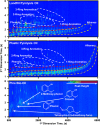The contribution of high-resolution GC separations in plastic recycling research
- PMID: 36650250
- PMCID: PMC10149442
- DOI: 10.1007/s00216-023-04519-8
The contribution of high-resolution GC separations in plastic recycling research
Abstract
One convenient strategy to reduce environmental impact and pollution involves the reuse and revalorization of waste produced by modern society. Nowadays, global plastic production has reached 367 million tons per year and because of their durable nature, their recycling is fundamental for the achievement of the circular economy objective. In closing the loop of plastics, advanced recycling, i.e., the breakdown of plastics into their building blocks and their transformation into valuable secondary raw materials, is a promising management option for post-consumer plastic waste. The most valuable product from advanced recycling is a fluid hydrocarbon stream (or pyrolysis oil) which represents the feedstock for further refinement and processing into new plastics. In this context, gas chromatography is currently playing an important role since it is being used to study the pyrolysis oils, as well as any organic contaminants, and it can be considered a high-resolution separation technique, able to provide the molecular composition of such complex samples. This information significantly helps to tailor the pyrolysis process to produce high-quality feedstocks. In addition, the detection of contaminants (i.e., heteroatom-containing compounds) is crucial to avoid catalytic deterioration and to implement and design further purification processes. The current review highlights the importance of molecular characterization of waste stream products, and particularly the pyrolysis oils obtained from waste plastics. An overview of relevant applications published recently will be provided, and the potential of comprehensive two-dimensional gas chromatography, which represents the natural evolution of gas chromatography into a higher-resolution technique, will be underlined.
Keywords: Comprehensive two-dimensional gas chromatography; Gas chromatography; Hydrocarbons; Mass spectrometry; Molecular characterization; Plastic waste composition; Pyrolysis oil.
© 2023. The Author(s).
Conflict of interest statement
The authors declare no competing interests.
Figures









References
-
- Plastics Europe (2021) Plastics-the Facts 2021 An analysis of European plastics production, demand and waste data.
-
- Plastics Europe (2022) The circular economy for plastics, a European overview.
-
- Rao MN, Sultana R, Kota SH (2017) Municipal solid waste. In: Solid and hazardous waste management. Elsevier, pp 3–120
-
- Nanda S, Berruti F. Municipal solid waste management and landfilling technologies: a review. Environ Chem Lett. 2021;19:1433–1456. doi: 10.1007/s10311-020-01100-y. - DOI
Publication types
LinkOut - more resources
Full Text Sources
Miscellaneous

